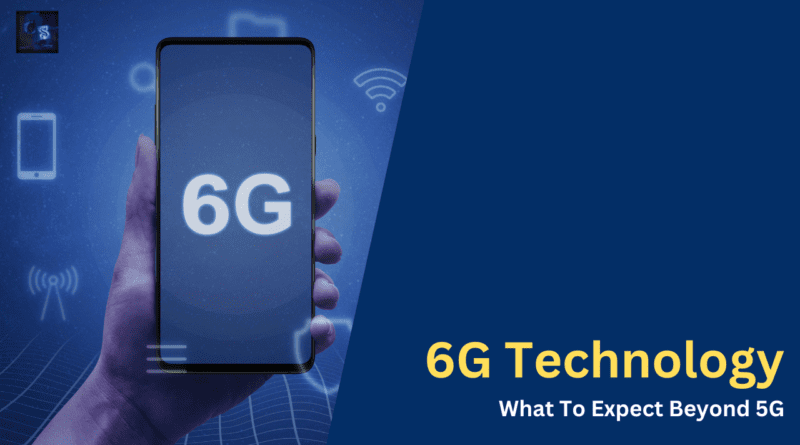6G Technology: What To Expect Beyond 5G
Hello, guys, welcome to our blog. Here in this article, we will discuss 6G technology, the evolution of 6G technology, and trends in 6G technology.
Ask questions if you have any electrical, electronics, or computer science doubts. You can also catch me on Instagram – CS Electrical & Electronics.
Also, read:
- What Is HiL, Hardware In Loop, Working, Tools Used In HiL
- What Is CPC (Common Powertrain Controller) ECU, Working of CPC
- UDS (Unified Diagnostic Services) Tutorials For Automotive Engineers
6G Technology
As we stand on the point of the 5G era, discussions and research are already underway to pave the way for the next generation of wireless technology – 6G. Envisioned as the successor to 5G, 6G technology aims to push the boundaries of connectivity, unlocking unprecedented speeds, responsiveness, and capabilities. While 5G has brought about significant improvements in data transfer rates, 6G is poised to revolutionize the digital landscape with innovations that go beyond faster downloads.
1. Hyperconnectivity and Data Rates: At the core of 6G’s vision is hyperconnectivity, where an even greater number of devices seamlessly communicate with each other. Anticipated data rates are expected to be several times faster than 5G, potentially reaching terabits per second. This quantum leap in data rates will not only enhance the user experience but also empower emerging technologies like augmented reality (AR), virtual reality (VR), and the Internet of Things (IoT).
2. Ultra-Low Latency: 6G aims to redefine latency standards, reducing the time it takes for data to travel between devices to near-instantaneous levels. This ultra-low latency is crucial for applications that demand real-time responsiveness, such as autonomous vehicles, remote surgery, and immersive gaming experiences. By minimizing delays, 6G will enable a new era of interactive and responsive technologies.
3. TeraHertz (THz) Frequencies: 6G is expected to leverage higher frequency bands, including TeraHertz frequencies, to accommodate the surge in data demand. This shift enables the transmission of massive amounts of data quickly, opening possibilities for faster and more efficient wireless communication. However, harnessing THz frequencies poses technological challenges that researchers are actively addressing.
4. AI Integration: Artificial Intelligence (AI) integration is a key aspect of 6G technology. By incorporating AI algorithms at various network levels, 6G networks can dynamically adapt to changing conditions, optimize resource allocation, and enhance overall network efficiency. Intelligent networks will play a pivotal role in providing personalized and context-aware services to users.
5. Sustainability and Green Communication: Recognizing the environmental impact of technology, 6G aims to prioritize sustainability. Green communication initiatives will focus on minimizing energy consumption, reducing electronic waste, and adopting eco-friendly practices. This commitment aligns with global efforts to create technology solutions that are both advanced and environmentally responsible.
6. Global Connectivity and Accessibility: 6G seeks to bridge the digital divide by extending connectivity to remote and underserved areas globally. Through satellite networks, advanced communication infrastructure, and innovative deployment strategies, 6G aims to provide seamless connectivity, empowering communities and economies around the world.
As 6G technology takes shape, it represents more than just an incremental advancement; it signifies a paradigm shift in how we connect, communicate, and experience the digital realm. While the widespread deployment of 6G is still on the horizon, the ongoing research and conceptualization of its capabilities promise a future where connectivity transcends current limitations, opening new frontiers of innovation and societal transformation.
Evolution Of 6G Technology
The evolution of wireless communication technology has witnessed remarkable strides with each generation, and 6G stands at the forefront of this ongoing progression. Although it is still in the conceptual and research phase, the envisioned evolution of 6G technology represents a convergence of cutting-edge advancements that promise to redefine the way we experience connectivity.
1. Building on 5G Foundations: The evolution from 5G to 6G builds upon the foundations laid by the current generation. 5G, with its enhanced data speeds and low latency, has provided a glimpse into the possibilities of high-speed, reliable wireless communication. 6G aims to take these capabilities to unprecedented levels, pushing the boundaries of achievable data rates, responsiveness, and connectivity.
2. Terahertz Frequencies and Beyond: One of the key aspects of 6G’s evolution is the exploration of higher frequency bands, including Terahertz (THz) frequencies. While 5G primarily operates in the sub-6 GHz and millimeter-wave bands, 6G envisions utilizing THz frequencies to accommodate the ever-growing demand for data. This leap in frequency allows for the transmission of massive amounts of data at faster rates.
3. Quantum Communication and Cryptography: As part of its evolution, 6G is anticipated to explore the integration of quantum communication and cryptography. Quantum technologies could revolutionize secure communication by leveraging the principles of quantum entanglement and superposition. This would introduce a new era of ultra-secure and unbreakable communication channels.
4. Intelligent and Adaptive Networks: 6G is expected to feature knowledgeable and adaptive networks, leveraging Artificial Intelligence (AI) and machine learning algorithms. These technologies will enable the network to autonomously adapt to varying conditions, optimize resource allocation, and provide personalized services to users. The intelligence embedded in 6G networks will contribute to efficient and context-aware communication.
5. Hyperconnectivity and Ubiquitous Computing: Building on the concept of hyperconnectivity, 6G envisions a world where an even larger number of devices are seamlessly interconnected. This includes not only smartphones and computers but also a myriad of IoT devices, sensors, and smart infrastructure. Ubiquitous computing capabilities will transform how we interact with our surroundings, creating a seamlessly connected environment.
6. Holographic Communication and Extended Reality (XR): The evolution of 6G aims to bring forth advancements in holographic communication and Extended Reality (XR). Users may experience immersive and interactive holographic communication, blurring the lines between physical and virtual spaces. This evolution aligns with the growing demand for more realistic and engaging communication experiences.
7. Green and Sustainable Technologies: Recognizing the environmental impact of technology, 6G’s evolution places a strong emphasis on green and sustainable practices. The development of energy-efficient communication technologies, along with eco-friendly deployment strategies, aims to minimize the carbon footprint of wireless networks.
As the evolution of the 6G unfolds, researchers and industry experts are working collaboratively to shape a future where connectivity transcends current limitations. While it may take several years for 6G to become a reality, the ongoing exploration of its features and capabilities paints a compelling picture of a future where wireless communication is not just faster but also more intelligent, secure, and environmentally conscious.
Trends In 6G Technology
As researchers and innovators delve into the realm of 6G technology, several emerging trends are beginning to define the trajectory of this next-generation wireless communication standard. These trends encompass a wide range of advancements, from technical capabilities to novel applications, signaling a transformative shift in the landscape of connectivity.
1. Terahertz Spectrum Exploration: One of the prominent trends in 6G is the exploration of Terahertz (THz) frequencies. The use of the THz spectrum allows for unprecedented data rates and bandwidth, enabling faster and more efficient wireless communication. Researchers are focused on overcoming technical challenges associated with harnessing THz frequencies, paving the way for revolutionary advancements in data transmission.
2. Quantum Communication Integration: Quantum communication is emerging as a key trend in 6G technology. The integration of quantum principles, such as entanglement and superposition, promises ultra-secure communication channels. This trend aligns with the growing importance of secure and privacy-aware communication in an increasingly interconnected world.
3. Intelligent and Adaptive Networks: 6G is marked by the trend of intelligent and adaptive networks. Leveraging Artificial Intelligence (AI) and machine learning, these networks can autonomously adapt to changing conditions, optimize resource allocation, and deliver personalized services to users. The incorporation of intelligence enhances efficiency, responsiveness, and the overall user experience.
4. Holographic Communication and Extended Reality (XR): The trend towards holographic communication and Extended Reality (XR) is gaining prominence in 6G. This involves the integration of advanced technologies to enable immersive and interactive communication experiences. Users may engage in holographic meetings, gaming, and augmented reality applications, blurring the boundaries between the physical and virtual worlds.
5. Green and Sustainable Technologies: Sustainability is a prevailing trend in 6G technology. As the environmental impact of communication technologies becomes increasingly significant, researchers are focusing on developing green and sustainable practices. Energy-efficient solutions and eco-friendly deployment strategies aim to minimize the carbon footprint of 6G networks.
6. Ubiquitous and Hyperconnected Ecosystems: 6G is driving towards creating ubiquitous and hyperconnected ecosystems. The trend involves seamlessly integrating a vast array of devices, sensors, and infrastructure into a cohesive and interconnected network. This hyperconnectivity extends beyond traditional communication devices, encompassing various aspects of daily life, from smart cities to intelligent transportation systems.
7. Edge Computing Integration: Edge computing is emerging as a crucial trend in 6G, addressing the demand for low-latency and high-performance applications. By bringing computational capabilities closer to the end-users and devices, edge computing enhances the efficiency of data processing and communication. This trend is particularly relevant for applications such as autonomous vehicles, augmented reality, and real-time analytics.
8. Global Collaboration and Standardization: Given the global nature of communication standards, collaboration and standardization efforts are key trends in 6G development. International cooperation among researchers, industry players, and standardization bodies is essential for ensuring a unified approach to 6G implementation and deployment.
As these trends shape the evolution of 6G technology, ongoing research and development efforts will continue to unravel new possibilities. The collective pursuit of these advancements promises to deliver a future where connectivity is not only faster and more reliable but also intelligent, secure, and aligned with sustainable practices.
This was about “6G Technology: What to Expect Beyond 5G “. Thank you for reading.
Also, read:
- Advancements In Power Electronics For Energy Efficiency
- What Is HiL, Hardware In Loop, Working, Tools Used In HiL
- What Is CPC (Common Powertrain Controller) ECU, Working of CPC
- Exploring Electric Vehicles: Technology and Challenges
- The Future of Power Systems: Smart Grids
- What is XCP (Universal Measurement and Calibration Protocol)? Introduction, Working, Purpose, Applications
- What Is SIL Testing, Software-In Loop, Working, Purpose
Author Profile
- Content Writer








